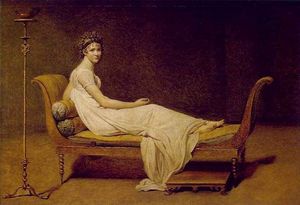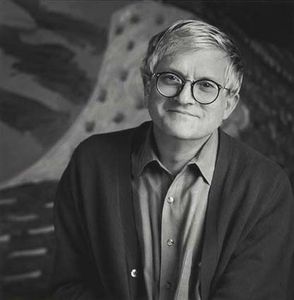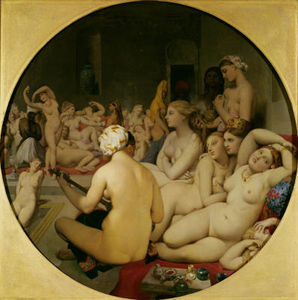La Grande Odalisque
- Date of Creation:
- 1814
- Alternative Names:
- Grande Odalisque, Une Odalisque
- Height (cm):
- 91.00
- Length (cm):
- 162.00
- Medium:
- Oil
- Support:
- Canvas
- Subject:
- Fantasy
- Framed:
- Yes
- Art Movement:
- Neoclassicism
- Created by:
- Current Location:
- Paris, France
- Displayed at:
- Musée du Louvre
- Owner:
- Musée du Louvre
La Grande Odalisque Story / Theme
It has been noted by some art historians that the elongation of the odalisque's back and pelvic area were not only drawn to satisfy Ingres' quest for an ideal form of the female body. Ingres was well-known for the way in which he reflected his subject's social condition through his paintings.
As it was the odalisque's duty to satisfy the carnal pleasures of the sultan, this elongation of her pelvic area may have been a symbolic distortion by Ingres. She lies on the divan, her nudity a signal that she is offering herself. She is described as a modest harem, as only her back and part of one breast is shown. But if one looks closely to her face, it seems aloof and absent of any sign of eager expectations.
A favorite subject of Ingres was the female nude. He loved to imaginatively enhance the female form as he considered it ideal. Often this meant strong anatomical distortions. La Grande Odalisque, one of his most well known nudes, is a fine display of such achievements. His use of color, lighting and the tone he evokes is unique, combined on the canvas in a way only Ingres could make successful.
La Grande Odalisque Inspirations for the Work
Ingres was fascinated by the customs of the near Eastern world and was particularly intrigued by the exotic sensuality of the Orient. With the common theme of the female nude, Ingres added his own preference by using an odalisque (a female slave of the harem; the household of the sultan) as his main inspiration for the work. He drew further inspiration from Jacques-Louis David, echoing the poses of a female figure from David's earlier painting.
Exotic cultures:
Ingres' liking of the near East can be seen throughout the majority of his work. The artist borrowed the idea of an odalisque, a pampered woman of pleasure, living in the household of the sultan, from the Orient. She is not only the main focus of this painting but also makes numerous appearances in Ingres' drawings and other works, emphasizing his fascination with the Orient.
David:
Ingres draws inspiration from a work done by his former teacher, Jacques-Louis David. The similarities between David's Portrait of Madame Récamier and Ingres' La Grande Odalisque can be seen when comparing the poses of the two figures. The odalisque reclines, looking back over her shoulder just as Madame Récamier does.
Both women are propped up against their left arms while their right arms lie across their bodies. The position of their feet is slightly different; the odalisque's left foot is further away from her right than in Madame Récamier. The major difference comes when Ingres adds his own personal touch; anatomical distortions. David portrays a female form truer to nature.
David left the work unfinished after finding out Juliette Récamier also commissioned François Gérard to paint a portrait of the same model before him.
La Grande Odalisque Analysis
Ingres desired to bring the exoticism of the Orient to his canvas in the nude commissioned by the queen of Naples.
Use of Space:
The body of the nude takes up the entire frame of the canvas. Her head, elbow, and buttocks are inches away from the edge of the canvas. Her toes actually extended beyond the bounds of the edge.
Techniques:
A technique unique to Ingres was his anatomical distortions, seen most particularly in his female nudes. In La Grande Odalisque the artist drew long sinuous lines to extend her back and pelvis area. Critics have said her body looks boneless.
Use of Color:
Under the classical training of David, Ingres was taught to focus more on drawing than on color. Though he paid meticulous attention to the details of the line, his use of colors is also carefully planned. He contrasts the warm tones of the nude's skin against the cool colored silk she lies on.
Lighting:
The foreground remains completely unlit, bringing attention to the long and sensuous body of the odalisque. It seems a spotlight has been cast directed on her body, specifically lighting and drawing attention to the area he elongates - her back and pelvis area, and her arm.
Tone elicited:
This piece is both sensual and erotic. The odalisque is offering herself to the sultan, welcoming him but giving him just a slight preview of her body. Only her bare back faces him and she entices while barely revealing her breast.
Brushstroke:
Ingres used tight brushwork to achieve his near photographic realism. He captured the likeness of the texture of the model's skin, the silk and the velvet.
La Grande Odalisque Critical Reception
By the time Ingres produced La Grande Odalisque aged 34 he should have been used to the harsh reaction of critics. The work Ingres exhibited at earlier salons was ridiculed but his exhibition of La Grande Odalisque at the Salon of 1819 proved the most shocking. Critics were outraged by the display of Ingres' wild imagination. This piece was received more positively after his death, influencing great artists as Degas and Picasso. Today, it invokes a positive response and is looked upon as one of Ingres' most memorable works.
Contemporary Reception:
Today, La Grande Odalisque is recognized as one of Ingres' most famous nudes. The anatomical distortions of the odalisque continue to fascinate art fans. Some reviewers have gone as far as to test the "three vertebrae too many" accusation made by critics of his day. After testing a series of models, they have concluded that the odalisque in fact has five vertebrae too many, not three.
La Grande Odalisque has been described by Baudelaire as a painter of "profound sensual delights."
Posthumous Reception:
The voyeurism, temptation and enigma of La Grande Odalisque is said to have had a profound effect on artists like Edgar Degas and Pablo Picasso. The works has also influenced Cindy Sherman and David Hockney.
Modern Day Reception:
Critics may have taken a slightly evil pleasure in judging the work of Ingres, an artist they loved to hate. Naturally, they had a field day at the Salon of 1819 with La Grande Odalisque, ridiculing Ingres' lack of conventional modeling and more noticeably, his anatomical distortions. One exclaimed that his "creature" had three vertebrae too many. Another remarked the work had "neither bones nor muscle, neither blood, nor life, nor relief, indeed nothing that constitutes imitation. "
It is apparent that critics of his day were not ready for Ingres' vivid, erotic imagination. The artist's use of long lines to convey curvature and sensuality caused Ingres' work to be criticized until the mid 1820s.
La Grande Odalisque Related Paintings
La Grande Odalisque Locations Through Time - Notable Sales
La Grande Odalisque was first in the possession of Napoleon's sister, Queen Caroline, who commissioned the work. It currently resides in the Musée du Louvre, Paris.
La Grande Odalisque Artist
The female nude was a favorite subject of Ingres. He loved to imaginatively enhance the female form as he considered it ideal and this often resulted in strong anatomical distortions. La Grande Odalisque, one of the artists' most famous nudes. His use of color, lighting and the tone he evokes is unique, combined on the canvas in a way only Ingres could make successful.
By the time Ingres produced La Grande Odalisque aged 34 he should have been used to the harsh reaction of critics. The work Ingres exhibited at earlier salons was ridiculed but his exhibition of La Grande Odalisque at the Salon of 1819 proved the most shocking. Critics were outraged by the display of Ingres' wild imagination. This piece was received more positively after his death, influencing great artists as Degas and Picasso. Today, it invokes a positive response and is looked upon as one of Ingres' most memorable works.
La Grande Odalisque Art Period
Neoclassicism is the 18th century revival of classical beliefs. It differs from other revivals as neoclassical artists approached the ancient subject with a newer, more scientific approach. They also combined an interest in both ancient worlds; Greece and Rome. The artifacts uncovered at Pompeii and Herculaneum contributed significantly to this rebirth of classicism.
Artists like Ingres portrayed the absolute truth of life through the "pure and simple" verities of antiquity. Neoclassicism replaced frivolity and superficiality of the Rococo movement.
La Grande Odalisque Bibliography
Find out more about this and Ingres's other works by referring to the recommended reading list below.
• Boime, Albert. Art in an Age of Bonapartism, 1800-1815. Chicago: Chicago University Press, 1993
• Fisher, Jay M. The Essence Of Line: French Drawings From Ingres To Degas. Pennsylvania: Pennsylvania State University Press, July, 2005
• Grimme, Karin H. Jean Auguste Dominique Ingres: Taschen Basic Art. New York: TASCHEN,December, 2006
• Vigne, Georges. Ingres. London: Abbeville Press, Incorporated. October, 1995















